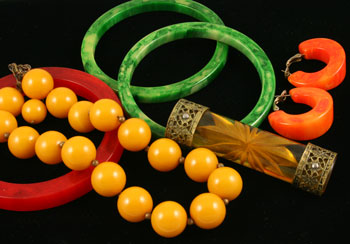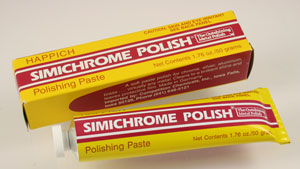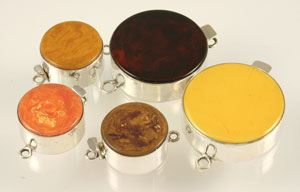 I’m not sure when I became obsessed, but I can tell you why! As a collector of the stuff, I must say that there is nothing else like genuine Bakelite! It has a feel, rich & deep sound (when tapping two pieces together), and even a smell that has a sort of "life" to it without being organic. In fact, Bakelite was the first completely synthetic plastic ever made. (FYI - The image to the left is from my collection just for your reference. These items are not for sale.)
I’m not sure when I became obsessed, but I can tell you why! As a collector of the stuff, I must say that there is nothing else like genuine Bakelite! It has a feel, rich & deep sound (when tapping two pieces together), and even a smell that has a sort of "life" to it without being organic. In fact, Bakelite was the first completely synthetic plastic ever made. (FYI - The image to the left is from my collection just for your reference. These items are not for sale.)
It was invented 1907 by a Belgian scientist named Dr. Leo Baekeland. He developed this compound by the reaction of heat and pressure of Phenol and Formaldehyde. When he tried to reheat the solidified compound, he discovered that it would not melt and that’s why Bakelite cannot be recycled. The fact that natural materials like ivory, horn and tortoise shell were becoming scarce made the discovery of Bakelite all the more exciting. Celluloid was the first replacement for ivory, but its big drawback was the fact that it is highly flammable and even explosive. Imagine the surprise of folks playing billiards with balls made of celluloid when putting a little too much effort into an initial break? An explosive thought, humm? Cinema film was made of celluloid that commonly burst into flames, and even caused some theaters to burn down. Since electrical technology was on the rise, the need for heat and moisture resistant insulating material became sought after. The discovery of Bakelite fit the bill and became known as the "material with 1000 s of uses". It was used to make anything and everything that you can think of that would be made of plastic of today.
I was told by an interesting antique dealer that many mobil homes had bakelite in the wall panels and that’s why they had a very strong smell. Bakelite was used to make radios, rotary telephones, medicine bottles, clocks, automobile dashboards, kitchen utensils, cameras, electrical plugs, comb & brush sets, tabletop & board games like chess pieces, dominos, dice, backgammon, Mahjong, billiard balls, children’s toys just to name a few. Oh, and did I mention the JEWELRY? How on earth could we forget that? In 1927 the Bakelite patent was expired and the Catalin Corporation acquired Bakelite. Bakelite-Catalin jewelry was sold to companies like Saks Fifth Avenue as well as Woolworth’s Five and Dime stores. Many European jewelry designers used Bakelite Beads and components in their designs such as Chanel, Yves St. Laurent and Dior. You will also find some Miriam Haskell designs with Bakelite beads. As the depression brought difficult financial times, Bakelite jewelry became very popular for all. It was colorful, a material that could be carved & moulded into beautiful shapes, and could be embellished with rhinestones and best of all, it was affordable for all. Take a look at our collection of authentic Bakelite Beads and Components. Discover a treasure trove of history, right here at A Grain of Sand.
 Smell is my first test. When heated it has a very strong odor from the formaldehyde. Very hot water can release the smell, but some pieces can release the smell simply by rubbing the Bakelite hard enough to create a little warmth. Once you have smelled genuine Bakelite, you will know it when you smell it again.
Smell is my first test. When heated it has a very strong odor from the formaldehyde. Very hot water can release the smell, but some pieces can release the smell simply by rubbing the Bakelite hard enough to create a little warmth. Once you have smelled genuine Bakelite, you will know it when you smell it again.
The Heat Test - Heat up a pin with an open flame until it is cherry red. Touch the Bakelite with the pin. If it is Bakelite it will not penetrate because bakelite will not melt. I am told that the heat test is popular, but I don’t recommend it as it can damage and devalue the piece by leaving a purple burn mark.
The formula 409 Test or the Simichrome Test - If you use some of either of these products to polish the bakelite, you should see that the cloth you use to rub will turn a deep yellow color. I prefer the Simichrome over 409 as it has a stronger reaction. Simichrome is available through our website in the Storage & Display section Item #12288 is also great for polishing all sorts of metals.
 By the end of "the War", that’s World War II, Bakelite became obsolete. Lucite, Fiberglass, Acrylic, and Vinyl are some of the "new age plastics" that replaced it although it is still used today in electronics as as substitute for porcelain components. So now, this old & cheap jewelry made from this early form of plastic known as Bakelite is highly collectable and valuable. Oh yeah. . . . I am obsessed with Vintage Bakelite. So I hunt for it like treasure. I have managed to find some to make into clasps as well from time to time. And, I have been known to share my Bakelite clasps. You can find some of these featured clasps for sale in the Clasps with Vintage Buttons & Stones section of the website.
By the end of "the War", that’s World War II, Bakelite became obsolete. Lucite, Fiberglass, Acrylic, and Vinyl are some of the "new age plastics" that replaced it although it is still used today in electronics as as substitute for porcelain components. So now, this old & cheap jewelry made from this early form of plastic known as Bakelite is highly collectable and valuable. Oh yeah. . . . I am obsessed with Vintage Bakelite. So I hunt for it like treasure. I have managed to find some to make into clasps as well from time to time. And, I have been known to share my Bakelite clasps. You can find some of these featured clasps for sale in the Clasps with Vintage Buttons & Stones section of the website.
